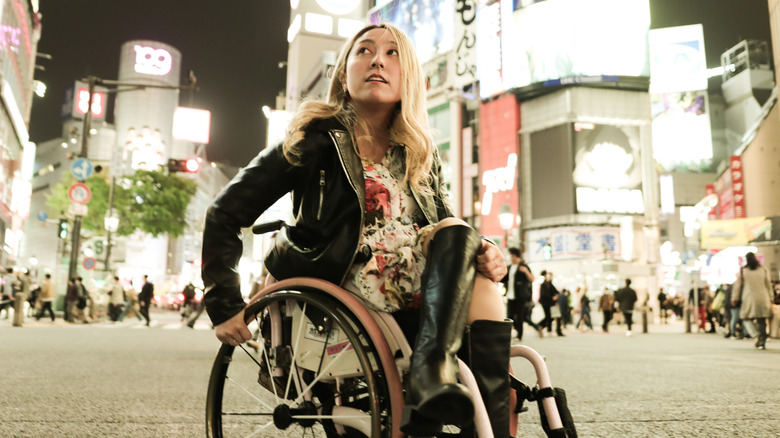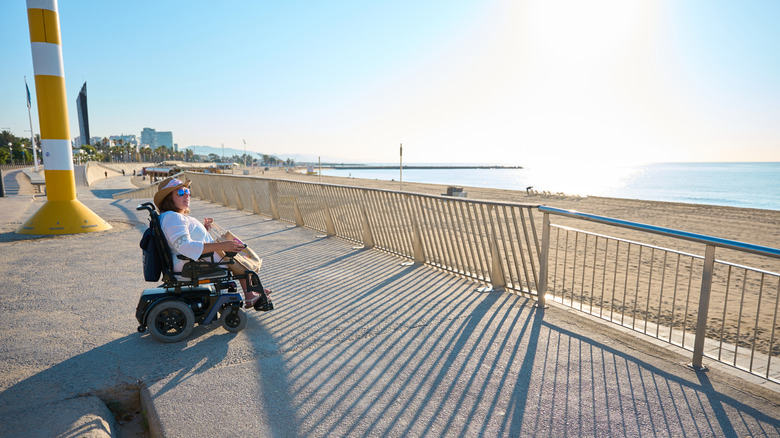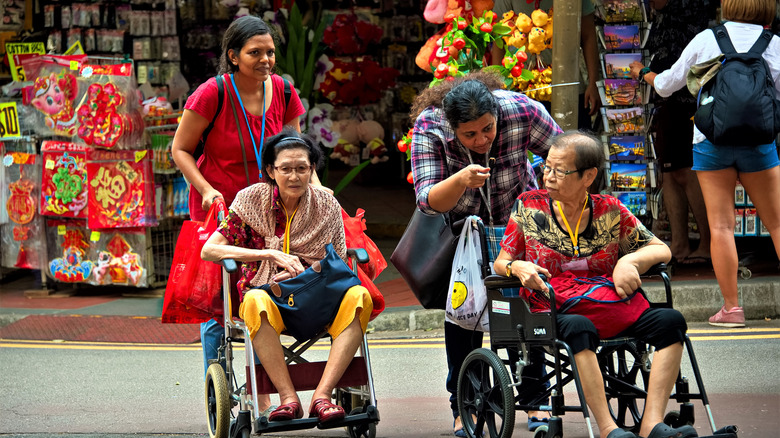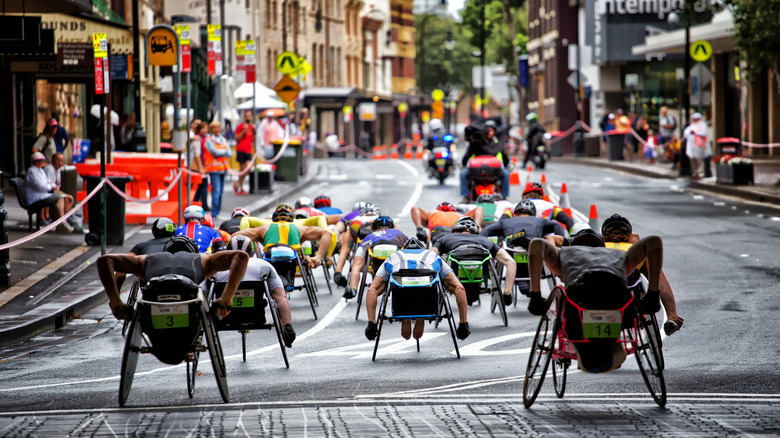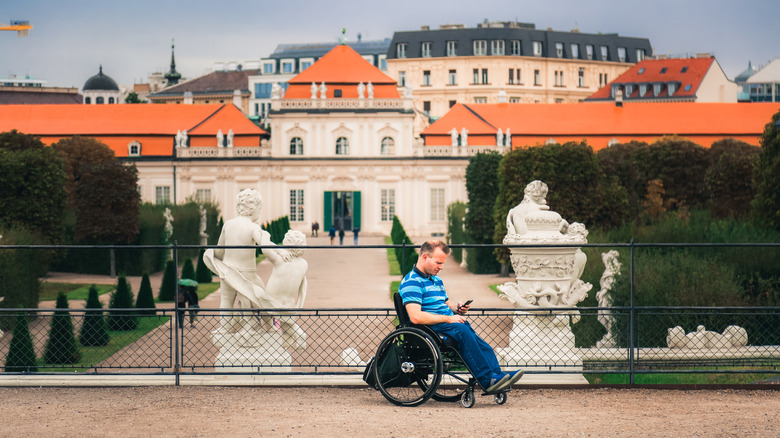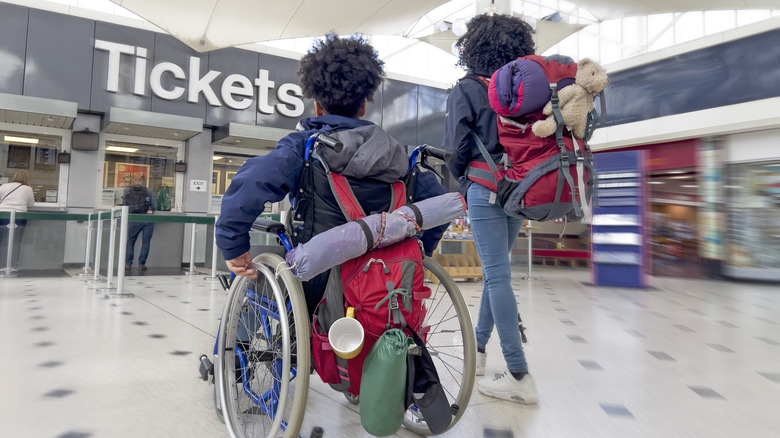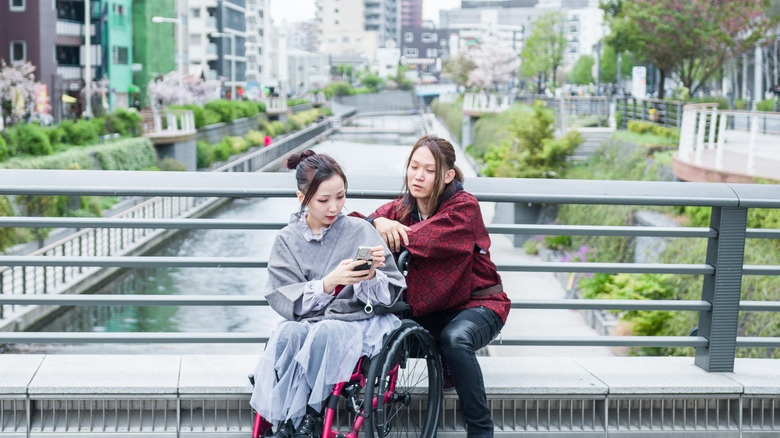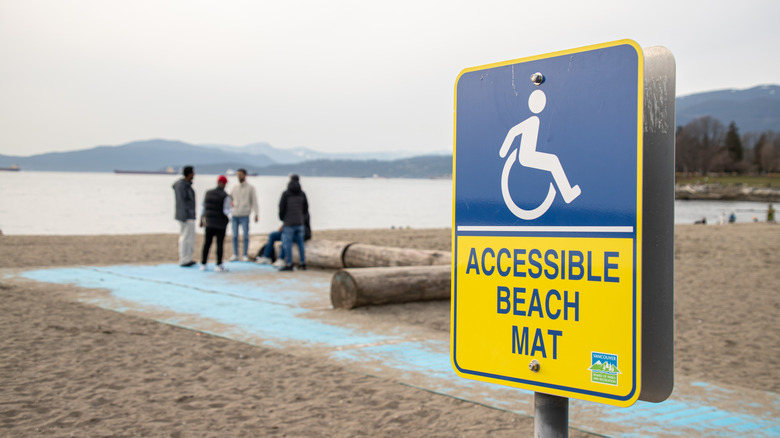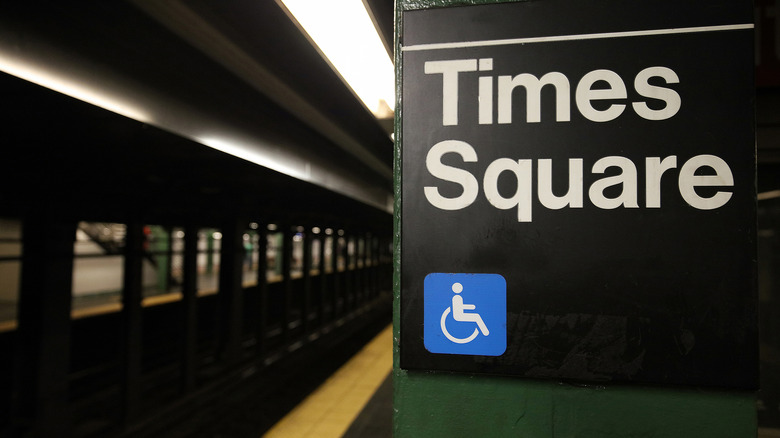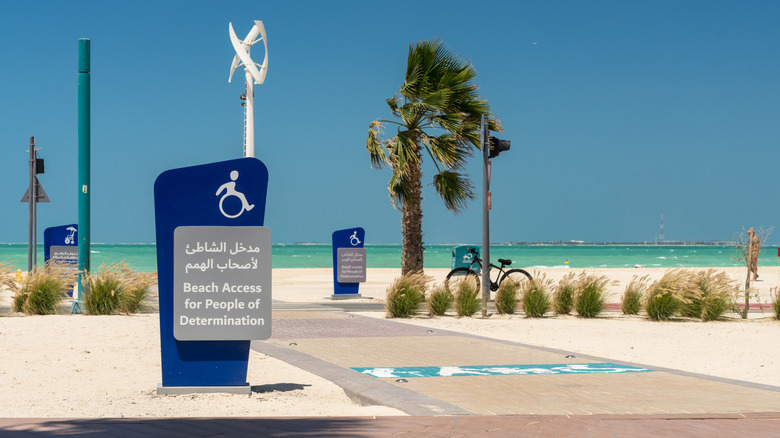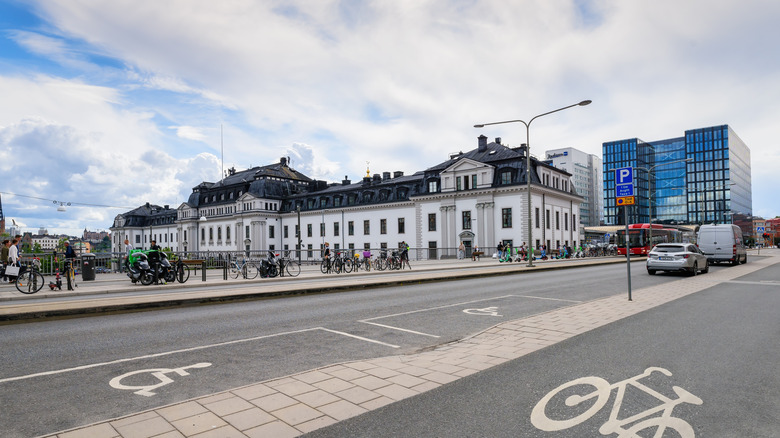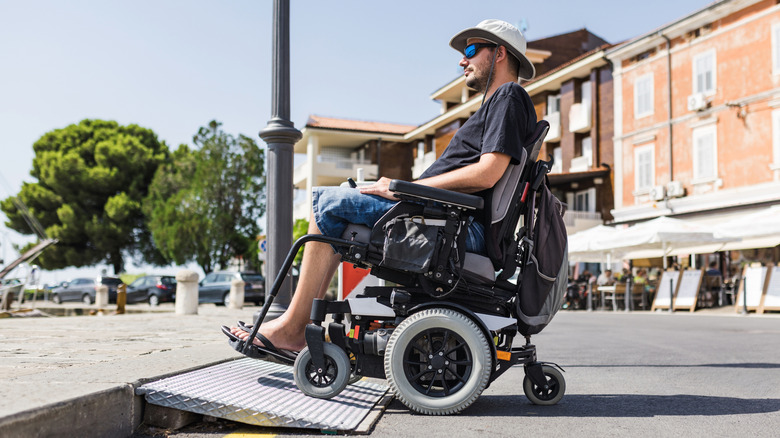The Best Cities In The World For Wheelchair Accessibility, According To Experts
Travel is for breaking down barriers, not putting them up. That should stretch the length of the human spectrum, from race and religion to sexual orientation and political affiliation. But there's no getting around the fact that some destinations just aren't viable for people with disabilities, especially those in wheelchairs.
It's a frustrating reality, but many cities aren't designed to cope with the modern world's requirements. Some can be forgiven (the cobbled, slopey streets of Istanbul are over a millennium old), but wherever possible, there should be a considered effort to make cities and the tourist attractions within them as accessible as possible. Elsewhere in the travel industry, airlines like JetBlue are setting the standard for wheelchair accessibility. Many cities are embracing the same mentality, ensuring that public transportation, museums, restaurants, and everything in between are being adapted to welcome visitors of all kinds.
From historic European capitals reimagining those beloved cobbles to cutting-edge Asian hubs building accessibility into every new development, the list of wheelchair-friendly destinations is broader and more exciting than ever. We've brought together a list of the best cities in the world for wheelchair access, whether they were built ready for everyone or are investing in disability-friendly infrastructure. Of course, some are in better shape than others, but the important aspect of each is that an effort is being made to adapt.
Barcelona, Spain
Barcelona has long been at the forefront of accessible travel in Europe. This is helped immensely by its comparatively flat terrain and broad, grid-built avenues, but the city's commitment to inclusivity stretches far beyond its geographical and architectural luck. The municipal authorities have worked to weave accessibility into almost every aspect of the tourist experience in the Spanish city.
The basic infrastructure of the city has already been adapted, especially in the Eixample District, with its broad streets, smooth sidewalks, and ramped kerbs. However, the shining light of Barcelona's accessibility initiative is its public transportation. Every bus in the city is fully wheelchair accessible, most cabs follow suit, and almost every metro station is fitted with ramps and elevators. Even the beaches, often tough to adapt, are surprisingly accessible. The main spots have walkways, amphibious chairs, and even accessible changing rooms.
With so many tourist draws in Barcelona, not everything is going to be perfectly accessible, but the city is making a good go of it and claims that almost all of its main attractions are at least partially accessible. Spots like the iconic Sagrada Família (the best tourist attraction in the world for 2025) have ramps and elevators installed throughout, allowing tourists with disabilities to see the work of Gaudí up close. It's a similar story at the Picasso Museum and even Barcelona FC's iconic Nou Camp stadium (currently undergoing renovations), where tours have been made fully accessible. It's a city that sets the standard for wheelchair accessibility worldwide.
Singapore
On the other side of the planet, the tiny city-state of Singapore is proving how well a modern city can weave accessibility into every aspect of its design. As a city that has largely developed over the past few decades, Singapore does have an advantage over other destinations that must contend with hundreds or even thousands of years of old infrastructure. With that in mind, the Lion City serves as a symbol of the future for accessibility.
Its public transport system is almost fully accessible, with the MRT (Mass Rapid Transit) and bus networks both catering to wheelchair users, and its sidewalks are wide, smooth, and lined with curb cuts, making navigation a breeze for anyone. All of those features are immaculately well looked after, too. You won't find much of a delay in repairing cracked or broken pavement, and its transport system runs like clockwork. Even the UNESCO-protected street food culture in Singapore is accessible, despite its traditional roots.
Singapore's tourist attractions are equally well designed. The iconic Marina Bay Sands Hotel has wheelchair-accessible observation decks, ensuring everyone can take in the city from the best vantage point, while the ethereal Gardens by the Bay has designed set routes through the site that avoid all barriers. Even Sentosa Island, the city's beach hub and theme park central, has made it a priority by introducing specialized trams and accessible beach areas.
Sydney, Australia
Sydney is a regular feature at the top of the world's best quality of life lists. While that's a general plaudit, it's no coincidence that the effort the city puts into living standards extends to people with disabilities. The sprawling city's stunning green spaces and denser urban areas could have been impossible to navigate by wheelchair, but the city is built with inclusivity in mind.
Sydney's ferries, buses, and trains are all wheelchair-friendly, allowing anyone to hop comfortably between neighborhoods — and that's important here, as Sydney covers a lot of ground. Even in the northern beaches, such as the iconic seaside spots of Manly and Bondi, there are beach wheelchairs on hand to allow everyone to enjoy the best the city has to offer. The city's countless world-class attractions are all great in this respect. Tours of the Sydney Opera House have step-free entry and specialized tours, while the Royal Botanic Gardens and Taronga Zoo are all equipped with ramps and lifts, ensuring people in wheelchairs can enjoy the great outdoors and Australian wildlife.
Sydney's charm comes from its best-of-both-worlds existence. It's an immense city, with all the trappings of a concrete jungle, but it marries that with a stunning array of outdoor spaces. It caters to every side of living, so why wouldn't it cater to every type of person? There can't be many places in the world where a wheelchair user can board a train from the city center and take part in an adapted surfing class with barely any problems.
Vienna, Austria
Sure, Vienna might be known for its dazzling culture, whether that's the opera, the art galleries, or the architecture, but the Austrians are also nothing if not practical, and that helps make the capital one of the most accessible cities in Europe. The city has enjoyed significant investment in the accessibility sector, ensuring its transport system is fully inclusive, with low-floor trams and buses, as well as lifts and ramps at stations. Getting between the never-ending parade of museums, palaces, and stately cafes is easy for everyone, with or without a wheelchair. With all this, it's no surprise that Vienna was one of the most livable cities in the world in 2025.
The city excels at cultural inclusivity, which is especially impressive considering the age of many of the buildings and the expertise required to adapt them safely. The Kunsthistorisches Museum and Belvedere Palace offer barrier-free routes, while Schönbrunn Palace, a UNESCO World Heritage site, has adapted tours for wheelchair users. Even traditional venues like the Vienna State Opera are equipped with accessible entrances and designated spaces for wheelchair seating.
The accessibility isn't limited to the museums and opera houses. The city has a number of beautifully manicured parks and gardens that have been adapted for wheelchair users. Stadtpark and the Prater Amusement area are both easily navigable on wheels, ensuring leisure time in the fresh Austrian air isn't limited. And, of course, the levels of hospitality in Vienna are second-to-none, so you can rest assured there will be help close at hand in most situations. The cultural importance of the city should be accessible to everyone, and Vienna makes sure that's the case.
London, United Kingdom
It's difficult to grasp the volume of planning and engineering that has gone into making London more accessible. Consider its labyrinth of Victorian-era tube stations. Once, these deeply dug tunnels were almost entirely inaccessible to anyone in a wheelchair. Now, over 200 stations have step-free access. That's a feat in itself and a testament to the city's investment in inclusivity. Every one of its iconic red buses is already wheelchair-friendly, as are the equally famous black cabs, making the entire city open to wheelchair exploration.
London has more blockbuster tourist attractions than most cities in the world. From the Tower of London and Buckingham Palace, to the London Eye and the British Museum, there's so much to see and do. Thankfully, the vast majority of those are now at least partially wheelchair accessible. Even exploring the city at your own pace can be easy. South Bank, Hyde Park, and many other outside spaces have been gifted with smooth, wide paths, well away from cars and with plenty of space for maneuvering. Of course, some attractions, like The Farraday Effect, the smallest museum in the world, can have limited accessibility due to the old architecture, but things are, on the whole, looking great in London.
The fact that London has managed to adapt so well (and continues to do so) while never compromising on its unique character and history is a massive success on the city planning side. Information about visiting the city using a wheelchair is widely available online, allowing for ample planning, and there are also tons of support services dotted around the center of London. It's not perfect quite yet, but it's well on its way to becoming one of the most accessible capitals in Europe.
Tokyo, Japan
Tokyo had a unique accessibility revolution, spurred on by a single event. In this case, it was the 2020 Paralympic Games. While the Japanese capital did have some wheelchair-friendly tourist attractions and public transportation, the arrival of the games kick-started an impressive inclusivity drive. Of course, thanks to the COVID-19 pandemic, the Olympics and Paralympics were postponed until 2021, and fan attendance was severely limited when the events were finally held. But the changes intended to make the games accessible for everyone have helped Tokyo immensely since then.
The city poured money and resources into upgrading public transportation, hotels, and tourist sites to meet international standards. Today, nearly every subway station is equipped with elevators and tactile paving, making navigation far easier than in decades past. It's not an easy city for anyone to get around without public transportation, never mind a person using a wheelchair, so this is a huge improvement.
Considering that Tokyo has built tourist attraction public toilets in its trendy Shibuya neighborhood, it should come as no surprise that a little adaptation is simple for its city planners. Its iconic attractions, such as the Tokyo Skytree, the Meiji Shrine, and even teamLab's immersive art experiences, are all wheelchair-friendly, while parks like Ueno and Yoyogi have multiple barrier-free paths, allowing visitors to sample everything the city has to offer. Even Tokyo Disneyland is fully inclusive. Further out of the city center, you'll find more traditional neighborhoods. While these won't be as consistently accessible as the urban heart, many now have specialized routes that avoid any major blocks or hurdles. The Japanese hospitality is, as always, welcoming and passionate, so never be afraid to ask for help in Tokyo.
Vancouver, Canada
Vancouver is a city designed with the outdoors in mind, and accessibility is part of that ethos. Once a city on the frontier, its sidewalks are now smooth and wide, public buses and the SkyTrain system are fully accessible, and ferries connecting to Granville Island and beyond are wheelchair-friendly. This all-encompassing infrastructure makes it easy to explore the city's multicultural neighborhoods and waterfront.
Still, what is a visit to Vancouver without experiencing the great outdoors? Luckily, that's a highlight of its inclusivity mission. The Seawall, a scenic path circling the waterfront, is flat and wheelchair-friendly and perfect for getting to grips with the town. Further out, many mountain trails have adaptive routes, with incline gradients kept to an absolute minimum. Grouse Mountain even offers accessible gondolas and adaptive sports, from kayaking to skiing, putting the slopes, rivers, and more within touching distance for everyone.
Vancouver isn't just the outdoors, though. It's bursting with unique draws that stretch back to its early days as a lumber port, and even further to its indigenous roots. Cultural attractions, such as the Museum of Anthropology and the Vancouver Art Gallery, can help shine a light on that past and are completely accommodating for wheelchair users, while the city's hotels have fully embraced accessibility standards. Like Sydney, Vancouver is widely regarded as one of the most livable cities on the planet, so it's no surprise that it extends to travelers of all abilities.
New York City, United States
New York hasn't always been the best place for people with disabilities. In many ways, it still lags behind other major American cities. However, the Big Apple's struggles to remedy that make it worth including on this list, even if it's just for context.
Similar to London, it's fueled by a massive, yet aging, subway system that was built long before inclusivity was even considered, and some of its iconic apartment blocks still lack elevators. Currently, as many as 150 of the stations are wheelchair accessible, which represents around a third of the total stations. The good news is that the city has committed to remedying that in its entirety. The bad news, but proof of the undertaking, is that it will take until 2055 to do it. It's still not perfect, and it will take a long time, but the Big Apple has invested billions to upgrade its public transportation system.
NYC's buses are now fully accessible, and wheelchair-friendly cabs are becoming more common. As more subway stations are enhanced, the city will be traversable by all in no time. As for attractions, Central Park, Times Square, and countless museums, such as the Met and MoMA, are all wheelchair-friendly. Others, like the Statue of Liberty, offer adapted tours. The latter does have limitations, though. Top of the Rock, the stunning viewing deck on top of the Rockefeller Center, is fully wheelchair accessible, so there's no reason to miss out on the epic New York views either. The City That Never Sleeps is well on its way to becoming one of the better cities in the United States for accessibility.
Dubai, United Arab Emirates
Dubai has enjoyed the same benefits as Singapore, having built itself over the past few decades. There are no Victorian subways to contend with, no 1,000-year-old cobbled streets, and no UNESCO sites to destroy in making the city accessible to everyone. It's a blank canvas, and wheelchair users have been included in the plans from day one. It's a straightforward place to navigate in a wheelchair. Its sidewalks are wide and smooth, and they only give way to clean and well-adapted metro stations, all equipped with elevators.
Hotels and malls, which are a focal point of life in Dubai, are just as easy to navigate. Even with crowds, the sheer size of these shopping centers here leaves plenty of space for everyone. Throw in the ramps, adapted restrooms, and other additions, and things are looking good across the board. Other big attractions, like the Burj Khalifa observation deck, are easily accessible for wheelchair users, and even desert safaris now offer adaptable options. The sky is the limit here.
Dubai's focus on inclusivity is closely tied to its global image as a modern hub. While cultural authenticity is sometimes debated, its commitment to accessibility is undeniable. For travelers who want comfort, innovation, and accessibility woven together, Dubai sets a high standard.
Stockholm, Sweden
Stockholm's embrace of accessibility is deeply tied to its social ethos of equality. Ferries, buses, and trams are all fully accessible, even on routes weaving through the city's archipelago. Sidewalks and public buildings are designed with inclusivity as a baseline, making it easier for wheelchair users to navigate the city's historic charm and modern design.
The city is brimming with cultural highlights like the Vasa Museum, the ABBA Museum, and the Royal Palace, all of which have wheelchair-friendly routes. Additionally, the parks and outdoor spaces so closely tied to Swedish life are also a breeze. Travelers with disabilities will have few problems making their way around this vibrant city. It's literally written into law that not catering for disabilities is a form of discrimination, so you can rest assured that any new buildings or tourist attractions will have mandated features like ramps and even turning spaces on every floor.
Stockholm proves that accessibility isn't just a matter of retrofitting. It's a mindset, and seamless integration of inclusivity into urban design makes the city a joy to explore for everyone, whether you're rolling along the waterfront promenades or catching a ferry to a nearby island. There will be some exceptions in older buildings, of course, but on the whole, it's an amazing place for people with disabilities.
Methodology
We built this article by examining multiple tourist sites around the world, all with vastly different infrastructure systems, ages, and outlooks. From there, we looked into local government and tourist websites to check policies and adaptations that have been made to accommodate people with disabilities. After finding a few interesting destinations, we scanned for travel bloggers with disabilities to see how they coped in each of the chosen cities, as it's not outside the realm of possibility that some local councils may overblow their own accessibility.
While we have listed 10 destinations, they're not in any distinct order, as each has its own merits. For pure accessibility, Dubai and Singapore are probably the strongest as they've had the most flexibility in building their cities.
